Counting Washtenaw County Pedestrians and Bicyclists
/Over the past year, WATS has been working with communities in the urban area on pilot testing permanent bicycle and pedestrian counters. After researching numerous companies and reviewing the reliability of the products, WATS determined to partner with the company Eco-Counter. The counters will be installed in Pittsfield Township and the City of Dexter later this year. Collecting data that highlights the number of people using a facility is important for communities to evaluate the return on their investment. According to Eco-Counter, in 2015 more than 2 billion people were counted on their products, and since January 1, 2016 their counters have counted over 800 million pedestrians and bicyclists. Eco-Counters has a interactive bike count display website that shows some of the cities where counters have been installed and how many counts have been taken, check it out http://eco-public.com/ParcPublic/?id=4586#.
WATS Director, Ryan Buck stated that “these counters will provide the most complete set of non-motorized data we’ve ever had for individual locations. The level of detail in the data will provide new insights into transportation system usage and aid in the planning and development of the region’s non-motorized system”.
The benefits of walking and biking are well-known but the monetary value of having these types of facilities is less understood. According to the Community and Economic Benefits of Bicycling in Michigan report created for the Michigan Department of Transportation, 2014 (report http://1.usa.gov/1rPyyqT), concluded the benefits for the state of Michigan for bicycling is $668 million annually:
Household retail spending on bicycling - $175 million
Manufacturing - $11 million
Avoided health care costs - $256 million
Reduced absenteeism - $187 million
Event and tourism spending - $38 million
Enjoy Bike to Work Week.





















